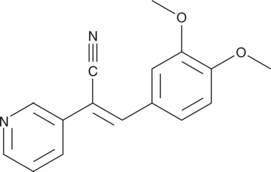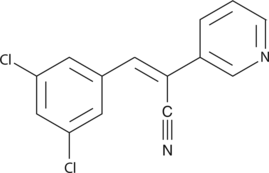Chemicals
Showing 34201–34350 of 41137 results
-
Reveromycin A is the major component of a complex of spiroketal antibiotics isolated from Streptomyces sp. It inhibits the mitogenic activity of epidermal growth factor in Balb/MK cells (IC50 = 0.7 µg/ml), displays antiproliferative activity against human KB and K562 tumor cell lines (IC50s = 1.9 and 1.6 µg/ml, respectively), and demonstrates antifungal activity against C. albicans (MIC = 2 µg/ml at pH 3).{28254} Reveromycin A also has been shown to inhibit bone resorption by inducing apoptosis in osteoclasts with an IC50 value of 0.7 µM.{28255}
Brand:CaymanSKU:-Available on backorder
Reveromycin B is a spiroketal bacterial metabolite originally isolated from Streptomyces.{28254} It inhibits EGF-induced mitogenic activity in Balb/MK cells (IC50 = 6 μg/ml) and exhibits pH-dependent antifungal activity against C. albicans (MICs = 15.6 and >500 μg/ml at pH 3.0 and 7.4, respectively). Unlike reveromycin A (Item No. 17458) and reveromycin C (Item No. 23488), reveromycin B does not inhibit proliferation of KB and K562 cells.
Brand:CaymanSKU:25481 - 1 mgAvailable on backorder
Reveromycin B is a spiroketal bacterial metabolite originally isolated from Streptomyces.{28254} It inhibits EGF-induced mitogenic activity in Balb/MK cells (IC50 = 6 μg/ml) and exhibits pH-dependent antifungal activity against C. albicans (MICs = 15.6 and >500 μg/ml at pH 3.0 and 7.4, respectively). Unlike reveromycin A (Item No. 17458) and reveromycin C (Item No. 23488), reveromycin B does not inhibit proliferation of KB and K562 cells.
Brand:CaymanSKU:25481 - 250 µgAvailable on backorder
Reveromycin C is a polyketide originally isolated from Streptomyces that has antifungal activity against C. albicans (MICs = 2.0 and >500 µg/ml at pH 3 and 7.4, respectively).{36572,28254} Reveromycin C inhibits EGF-induced mitogenic activity in the Balb/MK mouse epidermal cell line.{28254} It also reverses the morphology of sarcoma-virus-transformed NRK rat kidney cells (EC50 = 1.58 µg/ml) and inhibits proliferation of KB cells and K562 human chronic myelogenous leukemia cells (IC50 = 2.0 µg/ml for both).{28254}
Brand:CaymanSKU:23488 - 1 mgAvailable on backorder
Reveromycin C is a polyketide originally isolated from Streptomyces that has antifungal activity against C. albicans (MICs = 2.0 and >500 µg/ml at pH 3 and 7.4, respectively).{36572,28254} Reveromycin C inhibits EGF-induced mitogenic activity in the Balb/MK mouse epidermal cell line.{28254} It also reverses the morphology of sarcoma-virus-transformed NRK rat kidney cells (EC50 = 1.58 µg/ml) and inhibits proliferation of KB cells and K562 human chronic myelogenous leukemia cells (IC50 = 2.0 µg/ml for both).{28254}
Brand:CaymanSKU:23488 - 250 µgAvailable on backorder
Reveromycin D is a bacterial metabolite originally isolated from Streptomyces.{47366} It inhibits EGF-induced mitogenic activity in Balb/MK cells and has pH-dependent antifungal activity against C. albicans (MICs = 2 and >500 μg/ml at pH 3 and 7.4, respectively).{28254} Reveromycin D also inhibits proliferation of KB and K562 cells (IC50s = 1.6 and 1.3 μg/ml, respectively).
Brand:CaymanSKU:28101 - 1 mgAvailable on backorder
Reveromycin D is a bacterial metabolite originally isolated from Streptomyces.{47366} It inhibits EGF-induced mitogenic activity in Balb/MK cells and has pH-dependent antifungal activity against C. albicans (MICs = 2 and >500 μg/ml at pH 3 and 7.4, respectively).{28254} Reveromycin D also inhibits proliferation of KB and K562 cells (IC50s = 1.6 and 1.3 μg/ml, respectively).
Brand:CaymanSKU:28101 - 250 µgAvailable on backorder
Reversin 121 is a hydrophobic peptide chemosensitizer that can reverse P-glycoprotein-mediated multidrug resistance. It binds to the P-glycoprotein multidrug transporter (MDR1) with a Kd value of 77 nM.{30974,30795} Reversin 121 modulates P-glycoprotein ATPase activity in Sf9 insect cell membranes expressing human MDR1, plasma membrane vesicles from multidrug-resistant cells, and reconstituted proteoliposomes as well as in a variety of MDR1-expressing intact tumor cells.{30974}
Brand:CaymanSKU:-Available on backorder
Reversin 121 is a hydrophobic peptide chemosensitizer that can reverse P-glycoprotein-mediated multidrug resistance. It binds to the P-glycoprotein multidrug transporter (MDR1) with a Kd value of 77 nM.{30974,30795} Reversin 121 modulates P-glycoprotein ATPase activity in Sf9 insect cell membranes expressing human MDR1, plasma membrane vesicles from multidrug-resistant cells, and reconstituted proteoliposomes as well as in a variety of MDR1-expressing intact tumor cells.{30974}
Brand:CaymanSKU:-Available on backorder
Reversin 121 is a hydrophobic peptide chemosensitizer that can reverse P-glycoprotein-mediated multidrug resistance. It binds to the P-glycoprotein multidrug transporter (MDR1) with a Kd value of 77 nM.{30974,30795} Reversin 121 modulates P-glycoprotein ATPase activity in Sf9 insect cell membranes expressing human MDR1, plasma membrane vesicles from multidrug-resistant cells, and reconstituted proteoliposomes as well as in a variety of MDR1-expressing intact tumor cells.{30974}
Brand:CaymanSKU:-Available on backorder
Reversine is a 2,6-disubstituted purine derivative that was originally found to induce dedifferentiation of C2C12 culture myoblast cells into stem cell progenitors when used at a concentration of 5 µM for four days.{12913} Depending on cell type, reversine promotes either differentiation or dedifferentiation. For example, in NT2 neuronal and HL-60 human promyelocytic leukemia cells, it induces differentiation.{38283} It inhibits the Aurora A, B, and C kinases with IC50 values of 98-876 nM and acts as an antagonist at the adenosine A3 receptor with a Ki value of 0.66 µM.{38283,13281,38284} Reversine is also used for studies of chromosome segregation. It inhibits the mitotic spindle checkpoint enzyme MPS1 with IC50 values of 6 and 2.8 nM for its kinase domain and full-length version, respectively).{38284} Reversine induces autophagy in WRO human follicular thyroid cancer cells and decreases Akt/mTOR signaling.{34281}
Brand:CaymanSKU:10004412 - 1 mgAvailable on backorder
Reversine is a 2,6-disubstituted purine derivative that was originally found to induce dedifferentiation of C2C12 culture myoblast cells into stem cell progenitors when used at a concentration of 5 µM for four days.{12913} Depending on cell type, reversine promotes either differentiation or dedifferentiation. For example, in NT2 neuronal and HL-60 human promyelocytic leukemia cells, it induces differentiation.{38283} It inhibits the Aurora A, B, and C kinases with IC50 values of 98-876 nM and acts as an antagonist at the adenosine A3 receptor with a Ki value of 0.66 µM.{38283,13281,38284} Reversine is also used for studies of chromosome segregation. It inhibits the mitotic spindle checkpoint enzyme MPS1 with IC50 values of 6 and 2.8 nM for its kinase domain and full-length version, respectively).{38284} Reversine induces autophagy in WRO human follicular thyroid cancer cells and decreases Akt/mTOR signaling.{34281}
Brand:CaymanSKU:10004412 - 10 mgAvailable on backorder
Reversine is a 2,6-disubstituted purine derivative that was originally found to induce dedifferentiation of C2C12 culture myoblast cells into stem cell progenitors when used at a concentration of 5 µM for four days.{12913} Depending on cell type, reversine promotes either differentiation or dedifferentiation. For example, in NT2 neuronal and HL-60 human promyelocytic leukemia cells, it induces differentiation.{38283} It inhibits the Aurora A, B, and C kinases with IC50 values of 98-876 nM and acts as an antagonist at the adenosine A3 receptor with a Ki value of 0.66 µM.{38283,13281,38284} Reversine is also used for studies of chromosome segregation. It inhibits the mitotic spindle checkpoint enzyme MPS1 with IC50 values of 6 and 2.8 nM for its kinase domain and full-length version, respectively).{38284} Reversine induces autophagy in WRO human follicular thyroid cancer cells and decreases Akt/mTOR signaling.{34281}
Brand:CaymanSKU:10004412 - 25 mgAvailable on backorder
Reversine is a 2,6-disubstituted purine derivative that was originally found to induce dedifferentiation of C2C12 culture myoblast cells into stem cell progenitors when used at a concentration of 5 µM for four days.{12913} Depending on cell type, reversine promotes either differentiation or dedifferentiation. For example, in NT2 neuronal and HL-60 human promyelocytic leukemia cells, it induces differentiation.{38283} It inhibits the Aurora A, B, and C kinases with IC50 values of 98-876 nM and acts as an antagonist at the adenosine A3 receptor with a Ki value of 0.66 µM.{38283,13281,38284} Reversine is also used for studies of chromosome segregation. It inhibits the mitotic spindle checkpoint enzyme MPS1 with IC50 values of 6 and 2.8 nM for its kinase domain and full-length version, respectively).{38284} Reversine induces autophagy in WRO human follicular thyroid cancer cells and decreases Akt/mTOR signaling.{34281}
Brand:CaymanSKU:10004412 - 5 mgAvailable on backorder
RF9 is a neuropeptide FF (NPFF) receptor antagonist.{57271} It binds to human NPFF1 and NPFF2 receptors with Ki values of 58 and 75 nM, respectively. It is selective for NPFF1 and NPFF2 receptors over neuropeptide Y (NPY) receptor Y1, GPR10, GPR54, GPR103, ORL-1, and μ-, δ-, and κ-opioid receptors at 10 μM. RF9 (7.5 μM) inhibits NPFF-induced [35S]GTPγS binding to the NPFF2 receptor. It reverses NPVF-induced inhibition of forskolin-stimulated cAMP accumulation in CHO cells expressing the human NPFF1 receptor (EC50 = 4.7 μM). Intracerebroventricular administration of RF9 (10 μg) inhibits NPFF-induced increases in mean arterial pressure and heart rate in rats. It prevents heroin-induced delayed hyperalgesia and associated tolerance in rats when administered subcutaneously at a dose of 0.1 mg/kg.
Brand:CaymanSKU:31412 - 1 mgAvailable on backorder
RF9 is a neuropeptide FF (NPFF) receptor antagonist.{57271} It binds to human NPFF1 and NPFF2 receptors with Ki values of 58 and 75 nM, respectively. It is selective for NPFF1 and NPFF2 receptors over neuropeptide Y (NPY) receptor Y1, GPR10, GPR54, GPR103, ORL-1, and μ-, δ-, and κ-opioid receptors at 10 μM. RF9 (7.5 μM) inhibits NPFF-induced [35S]GTPγS binding to the NPFF2 receptor. It reverses NPVF-induced inhibition of forskolin-stimulated cAMP accumulation in CHO cells expressing the human NPFF1 receptor (EC50 = 4.7 μM). Intracerebroventricular administration of RF9 (10 μg) inhibits NPFF-induced increases in mean arterial pressure and heart rate in rats. It prevents heroin-induced delayed hyperalgesia and associated tolerance in rats when administered subcutaneously at a dose of 0.1 mg/kg.
Brand:CaymanSKU:31412 - 10 mgAvailable on backorder
RF9 is a neuropeptide FF (NPFF) receptor antagonist.{57271} It binds to human NPFF1 and NPFF2 receptors with Ki values of 58 and 75 nM, respectively. It is selective for NPFF1 and NPFF2 receptors over neuropeptide Y (NPY) receptor Y1, GPR10, GPR54, GPR103, ORL-1, and μ-, δ-, and κ-opioid receptors at 10 μM. RF9 (7.5 μM) inhibits NPFF-induced [35S]GTPγS binding to the NPFF2 receptor. It reverses NPVF-induced inhibition of forskolin-stimulated cAMP accumulation in CHO cells expressing the human NPFF1 receptor (EC50 = 4.7 μM). Intracerebroventricular administration of RF9 (10 μg) inhibits NPFF-induced increases in mean arterial pressure and heart rate in rats. It prevents heroin-induced delayed hyperalgesia and associated tolerance in rats when administered subcutaneously at a dose of 0.1 mg/kg.
Brand:CaymanSKU:31412 - 5 mgAvailable on backorder
DNA methylation regulates gene expression in normal and malignant cells. RG-108 is a non-nucleoside DNA methyltransferase inhibitor (IC50 = 115 nM in vitro).{17258} It significantly reduces the methylation of genomic DNA in cells at 10 μM without detectable toxicity, distinguishing it from nucleoside-based inhibitors like 5-azacytidine.{17257,17258} Further, RG-108 inhibits DNA methyltransferase activity by blocking the enzyme active site.{17257} Through these actions, RG-108 demethylates and reactivates epigenetically silenced tumor suppressor genes.{17258}
Brand:CaymanSKU:-DNA methylation regulates gene expression in normal and malignant cells. RG-108 is a non-nucleoside DNA methyltransferase inhibitor (IC50 = 115 nM in vitro).{17258} It significantly reduces the methylation of genomic DNA in cells at 10 μM without detectable toxicity, distinguishing it from nucleoside-based inhibitors like 5-azacytidine.{17257,17258} Further, RG-108 inhibits DNA methyltransferase activity by blocking the enzyme active site.{17257} Through these actions, RG-108 demethylates and reactivates epigenetically silenced tumor suppressor genes.{17258}
Brand:CaymanSKU:-DNA methylation regulates gene expression in normal and malignant cells. RG-108 is a non-nucleoside DNA methyltransferase inhibitor (IC50 = 115 nM in vitro).{17258} It significantly reduces the methylation of genomic DNA in cells at 10 μM without detectable toxicity, distinguishing it from nucleoside-based inhibitors like 5-azacytidine.{17257,17258} Further, RG-108 inhibits DNA methyltransferase activity by blocking the enzyme active site.{17257} Through these actions, RG-108 demethylates and reactivates epigenetically silenced tumor suppressor genes.{17258}
Brand:CaymanSKU:-DNA methylation regulates gene expression in normal and malignant cells. RG-108 is a non-nucleoside DNA methyltransferase inhibitor (IC50 = 115 nM in vitro).{17258} It significantly reduces the methylation of genomic DNA in cells at 10 μM without detectable toxicity, distinguishing it from nucleoside-based inhibitors like 5-azacytidine.{17257,17258} Further, RG-108 inhibits DNA methyltransferase activity by blocking the enzyme active site.{17257} Through these actions, RG-108 demethylates and reactivates epigenetically silenced tumor suppressor genes.{17258}
Brand:CaymanSKU:-Protein tyrosine kinase (PTK) inhibitors are potential antiproliferative agents for diseases caused by the hyperactivity of PTKs. Tyrphostins are a class of antiproliferative compounds that act as PTK blockers. PTK inhibitors that preferentially inhibit the epidermal growth factor (EGF) receptor kinase block EGF-dependent cell proliferation.{14963} RG-13022 is an inhibitor of epidermal growth factor (EGF) receptor kinase with an IC50 value of 1 µM in HT-22 cells.{14964}
Brand:CaymanSKU:10010309 - 10 mgAvailable on backorder
Protein tyrosine kinase (PTK) inhibitors are potential antiproliferative agents for diseases caused by the hyperactivity of PTKs. Tyrphostins are a class of antiproliferative compounds that act as PTK blockers. PTK inhibitors that preferentially inhibit the epidermal growth factor (EGF) receptor kinase block EGF-dependent cell proliferation.{14963} RG-13022 is an inhibitor of epidermal growth factor (EGF) receptor kinase with an IC50 value of 1 µM in HT-22 cells.{14964}
Brand:CaymanSKU:10010309 - 5 mgAvailable on backorder
Protein tyrosine kinase (PTK) inhibitors are potential antiproliferative agents for diseases caused by the hyperactivity of PTKs. Tyrphostins are a class of antiproliferative compounds that act as PTK blockers. PTK inhibitors that preferentially inhibit the epidermal growth factor (EGF) receptor kinase block EGF-dependent cell proliferation.{14963} RG-13022 is an inhibitor of epidermal growth factor (EGF) receptor kinase with an IC50 value of 1 µM in HT-22 cells.{14964}
Brand:CaymanSKU:10010309 - 50 mgAvailable on backorder
Protein tyrosine kinase (PTK) inhibitors are potential antiproliferative agents for diseases caused by the hyperactivity of PTKs. Tyrphostins are a class of antiproliferative compounds which act as PTK blockers. PTK inhibitors which preferentially inhibit the epidermal growth factor (EGF) receptor kinase block EGF-dependent cell proliferation.{14963} RG-14620 is an inhibitor of epidermal growth factor (EGF) receptor kinase with an IC50 value of 3 µM in HT-22 cells.{14964}
Brand:CaymanSKU:10010310 - 10 mgAvailable on backorder
Protein tyrosine kinase (PTK) inhibitors are potential antiproliferative agents for diseases caused by the hyperactivity of PTKs. Tyrphostins are a class of antiproliferative compounds which act as PTK blockers. PTK inhibitors which preferentially inhibit the epidermal growth factor (EGF) receptor kinase block EGF-dependent cell proliferation.{14963} RG-14620 is an inhibitor of epidermal growth factor (EGF) receptor kinase with an IC50 value of 3 µM in HT-22 cells.{14964}
Brand:CaymanSKU:10010310 - 5 mgAvailable on backorder
Protein tyrosine kinase (PTK) inhibitors are potential antiproliferative agents for diseases caused by the hyperactivity of PTKs. Tyrphostins are a class of antiproliferative compounds which act as PTK blockers. PTK inhibitors which preferentially inhibit the epidermal growth factor (EGF) receptor kinase block EGF-dependent cell proliferation.{14963} RG-14620 is an inhibitor of epidermal growth factor (EGF) receptor kinase with an IC50 value of 3 µM in HT-22 cells.{14964}
Brand:CaymanSKU:10010310 - 50 mgAvailable on backorder
RG-7112 is an inhibitor of mouse double-minute 2 protein (MDM2; IC50 = 0.018 µM), an E3 ubiquitin ligase that ubiquitinates the tumor suppressor p53 and also acts as a negative regulator of p53 transcriptional activity.{42617} RG-7112 binds to the p53 binding pocket of MDM2. It increases the levels of p53 and its transcriptional targets in SJSA-1 osteosarcoma cells.{42617,42618} It inhibits proliferation in cancer cell lines expressing wild-type p53 (IC50s = 0.18-2.2 µM) and cell lines expressing mutant p53 (IC50s = 5.7-20.3 µM). RG-7112 also prevents and reduces tumor growth in an SJSA-1 mouse xenograft model when administered at doses of 50 and 100 mg/kg per day, respectively.{42618} However, it inhibits thrombopoiesis in vivo, decreasing platelet counts in rats when administered at doses of 50 and 100 mg/kg and in cynomolgus monkeys at doses of 10 and 20 mg/kg.{42619}
Brand:CaymanSKU:25673 - 1 mgAvailable on backorder
RG-7112 is an inhibitor of mouse double-minute 2 protein (MDM2; IC50 = 0.018 µM), an E3 ubiquitin ligase that ubiquitinates the tumor suppressor p53 and also acts as a negative regulator of p53 transcriptional activity.{42617} RG-7112 binds to the p53 binding pocket of MDM2. It increases the levels of p53 and its transcriptional targets in SJSA-1 osteosarcoma cells.{42617,42618} It inhibits proliferation in cancer cell lines expressing wild-type p53 (IC50s = 0.18-2.2 µM) and cell lines expressing mutant p53 (IC50s = 5.7-20.3 µM). RG-7112 also prevents and reduces tumor growth in an SJSA-1 mouse xenograft model when administered at doses of 50 and 100 mg/kg per day, respectively.{42618} However, it inhibits thrombopoiesis in vivo, decreasing platelet counts in rats when administered at doses of 50 and 100 mg/kg and in cynomolgus monkeys at doses of 10 and 20 mg/kg.{42619}
Brand:CaymanSKU:25673 - 10 mgAvailable on backorder
RG-7112 is an inhibitor of mouse double-minute 2 protein (MDM2; IC50 = 0.018 µM), an E3 ubiquitin ligase that ubiquitinates the tumor suppressor p53 and also acts as a negative regulator of p53 transcriptional activity.{42617} RG-7112 binds to the p53 binding pocket of MDM2. It increases the levels of p53 and its transcriptional targets in SJSA-1 osteosarcoma cells.{42617,42618} It inhibits proliferation in cancer cell lines expressing wild-type p53 (IC50s = 0.18-2.2 µM) and cell lines expressing mutant p53 (IC50s = 5.7-20.3 µM). RG-7112 also prevents and reduces tumor growth in an SJSA-1 mouse xenograft model when administered at doses of 50 and 100 mg/kg per day, respectively.{42618} However, it inhibits thrombopoiesis in vivo, decreasing platelet counts in rats when administered at doses of 50 and 100 mg/kg and in cynomolgus monkeys at doses of 10 and 20 mg/kg.{42619}
Brand:CaymanSKU:25673 - 25 mgAvailable on backorder
RG-7112 is an inhibitor of mouse double-minute 2 protein (MDM2; IC50 = 0.018 µM), an E3 ubiquitin ligase that ubiquitinates the tumor suppressor p53 and also acts as a negative regulator of p53 transcriptional activity.{42617} RG-7112 binds to the p53 binding pocket of MDM2. It increases the levels of p53 and its transcriptional targets in SJSA-1 osteosarcoma cells.{42617,42618} It inhibits proliferation in cancer cell lines expressing wild-type p53 (IC50s = 0.18-2.2 µM) and cell lines expressing mutant p53 (IC50s = 5.7-20.3 µM). RG-7112 also prevents and reduces tumor growth in an SJSA-1 mouse xenograft model when administered at doses of 50 and 100 mg/kg per day, respectively.{42618} However, it inhibits thrombopoiesis in vivo, decreasing platelet counts in rats when administered at doses of 50 and 100 mg/kg and in cynomolgus monkeys at doses of 10 and 20 mg/kg.{42619}
Brand:CaymanSKU:25673 - 5 mgAvailable on backorder
RG7388 is a non-imidazoline, selective MDM2 inhibitor that blocks the binding of MDM2 to p53 (IC50 = 30 nM).{33578} By inhibiting MDM2, RG7388 activates the p53 pathway in SJSA1 osteosarcoma cells and inhibits the growth of xenografts in nude mice.{33578,33579} RG7388 is orally available and prolonged daily administration results in loss of MDM2 and p21 protein, growth inhibition, and apoptosis in SJSA1 xenograft tumors.{33579} Like other MDM2 inhibitors, RG7388 competitively inhibits multi-drug resistance protein 1 (MRP1) and reverse MRP1-mediated multidrug resistance in cancer cells in a p53-independent manner.{33577}
Brand:CaymanSKU:21532 -Out of stock
RG7388 is a non-imidazoline, selective MDM2 inhibitor that blocks the binding of MDM2 to p53 (IC50 = 30 nM).{33578} By inhibiting MDM2, RG7388 activates the p53 pathway in SJSA1 osteosarcoma cells and inhibits the growth of xenografts in nude mice.{33578,33579} RG7388 is orally available and prolonged daily administration results in loss of MDM2 and p21 protein, growth inhibition, and apoptosis in SJSA1 xenograft tumors.{33579} Like other MDM2 inhibitors, RG7388 competitively inhibits multi-drug resistance protein 1 (MRP1) and reverse MRP1-mediated multidrug resistance in cancer cells in a p53-independent manner.{33577}
Brand:CaymanSKU:21532 -Out of stock
RG7388 is a non-imidazoline, selective MDM2 inhibitor that blocks the binding of MDM2 to p53 (IC50 = 30 nM).{33578} By inhibiting MDM2, RG7388 activates the p53 pathway in SJSA1 osteosarcoma cells and inhibits the growth of xenografts in nude mice.{33578,33579} RG7388 is orally available and prolonged daily administration results in loss of MDM2 and p21 protein, growth inhibition, and apoptosis in SJSA1 xenograft tumors.{33579} Like other MDM2 inhibitors, RG7388 competitively inhibits multi-drug resistance protein 1 (MRP1) and reverse MRP1-mediated multidrug resistance in cancer cells in a p53-independent manner.{33577}
Brand:CaymanSKU:21532 -Out of stock
RG7388 is a non-imidazoline, selective MDM2 inhibitor that blocks the binding of MDM2 to p53 (IC50 = 30 nM).{33578} By inhibiting MDM2, RG7388 activates the p53 pathway in SJSA1 osteosarcoma cells and inhibits the growth of xenografts in nude mice.{33578,33579} RG7388 is orally available and prolonged daily administration results in loss of MDM2 and p21 protein, growth inhibition, and apoptosis in SJSA1 xenograft tumors.{33579} Like other MDM2 inhibitors, RG7388 competitively inhibits multi-drug resistance protein 1 (MRP1) and reverse MRP1-mediated multidrug resistance in cancer cells in a p53-independent manner.{33577}
Brand:CaymanSKU:21532 -Out of stock
RGB-286638 is a multi-kinase inhibitor.{47793} It inhibits a variety of kinases, including cyclin-dependent kinase 1 (CDK1), CDK2-7 and CDK9, as well as the tyrosine kinases FMS, JAK2, and c-Src and the serine/threonine kinases GSK3β, TAK1, JNK1A1, JNK1A2, AMPK, and MEK1 (IC50s = 1-55 nM). RGB-286638 inhibits proliferation of multiple myeloma cancer cell lines endogenously expressing mutant and wild-type p53 (EC50s = 20-70 nM), as well as patient-derived multiple myeloma cells when used at concentrations of 50 and 100 nM. It induces G1/S and G2/M cell cycle arrest and apoptosis of MM.1S human multiple myeloma cells when used at a concentration of 50 nM. RGB-286638 decreases tumor growth in an MM.1S mouse xenograft model when administered at doses of 30 and 40 mg/kg per day for 14 days.
Brand:CaymanSKU:29499 - 100 mgAvailable on backorder
RGB-286638 is a multi-kinase inhibitor.{47793} It inhibits a variety of kinases, including cyclin-dependent kinase 1 (CDK1), CDK2-7 and CDK9, as well as the tyrosine kinases FMS, JAK2, and c-Src and the serine/threonine kinases GSK3β, TAK1, JNK1A1, JNK1A2, AMPK, and MEK1 (IC50s = 1-55 nM). RGB-286638 inhibits proliferation of multiple myeloma cancer cell lines endogenously expressing mutant and wild-type p53 (EC50s = 20-70 nM), as well as patient-derived multiple myeloma cells when used at concentrations of 50 and 100 nM. It induces G1/S and G2/M cell cycle arrest and apoptosis of MM.1S human multiple myeloma cells when used at a concentration of 50 nM. RGB-286638 decreases tumor growth in an MM.1S mouse xenograft model when administered at doses of 30 and 40 mg/kg per day for 14 days.
Brand:CaymanSKU:29499 - 250 mgAvailable on backorder
RGB-286638 is a multi-kinase inhibitor.{47793} It inhibits a variety of kinases, including cyclin-dependent kinase 1 (CDK1), CDK2-7 and CDK9, as well as the tyrosine kinases FMS, JAK2, and c-Src and the serine/threonine kinases GSK3β, TAK1, JNK1A1, JNK1A2, AMPK, and MEK1 (IC50s = 1-55 nM). RGB-286638 inhibits proliferation of multiple myeloma cancer cell lines endogenously expressing mutant and wild-type p53 (EC50s = 20-70 nM), as well as patient-derived multiple myeloma cells when used at concentrations of 50 and 100 nM. It induces G1/S and G2/M cell cycle arrest and apoptosis of MM.1S human multiple myeloma cells when used at a concentration of 50 nM. RGB-286638 decreases tumor growth in an MM.1S mouse xenograft model when administered at doses of 30 and 40 mg/kg per day for 14 days.
Brand:CaymanSKU:29499 - 500 mgAvailable on backorder
RGD peptide is a synthetic compound made up of the arginine-glycine-aspartate motif that has been extensively used to inhibit integrin-ligand interactions in studies related to cell adhesion, migration, growth, and differentiation.{5588} RGD peptide has also been shown to directly induce apoptosis, independent of integrin-mediated cell clustering or signals, by initiating conformational changes that enhance pro-caspase-3 activation and autoprocessing.{7006,8479}
Brand:CaymanSKU:-RGD peptide is a synthetic compound made up of the arginine-glycine-aspartate motif that has been extensively used to inhibit integrin-ligand interactions in studies related to cell adhesion, migration, growth, and differentiation.{5588} RGD peptide has also been shown to directly induce apoptosis, independent of integrin-mediated cell clustering or signals, by initiating conformational changes that enhance pro-caspase-3 activation and autoprocessing.{7006,8479}
Brand:CaymanSKU:-RGD peptide is a synthetic compound made up of the arginine-glycine-aspartate motif that has been extensively used to inhibit integrin-ligand interactions in studies related to cell adhesion, migration, growth, and differentiation.{5588} RGD peptide has also been shown to directly induce apoptosis, independent of integrin-mediated cell clustering or signals, by initiating conformational changes that enhance pro-caspase-3 activation and autoprocessing.{7006,8479}
Brand:CaymanSKU:-RGD peptide is a synthetic compound made up of the arginine-glycine-aspartate motif that has been extensively used to inhibit integrin-ligand interactions in studies related to cell adhesion, migration, growth, and differentiation.{5588} RGD peptide has also been shown to directly induce apoptosis, independent of integrin-mediated cell clustering or signals, by initiating conformational changes that enhance pro-caspase-3 activation and autoprocessing.{7006,8479}
Brand:CaymanSKU:-Fibronectin is an extracellular matrix protein which binds other proteins and interacts with cells, serving roles in cell adhesion, migration, and signaling.{5588} Like vitronectin and collagen, fibronectin contains a conserved tripeptide sequence, Arg-Gly-Asp (RGD) to associate with integrins on the cell surface.{3775} RGDS peptide is a tetrapeptide found on fibronectin, fibrinogen α, and von Willebrand factor, but not vitronectin or collagen.{25165,25162} RGDS interacts with α5β1 and αVβ3 integrins.{25166} This tetrapeptide interferes with the attachment of cells to fibronectin-coated surfaces (Ki = 0.6 mM).{25165,25162} It also blocks the attachment of certain pathogens to cells.{25163,25164} RGDS peptide inhibits thrombin-induced binding of platelets to fibronectin, fibrinogen α, and von Willebrand factor (IC50 = ~10 μM).{25165,25167,25168} The interaction of RGDS peptide with cell surface integrins alters intracellular signaling in ways that are cell- and stimulus-specific.{25170,25169}
Brand:CaymanSKU:-Fibronectin is an extracellular matrix protein which binds other proteins and interacts with cells, serving roles in cell adhesion, migration, and signaling.{5588} Like vitronectin and collagen, fibronectin contains a conserved tripeptide sequence, Arg-Gly-Asp (RGD) to associate with integrins on the cell surface.{3775} RGDS peptide is a tetrapeptide found on fibronectin, fibrinogen α, and von Willebrand factor, but not vitronectin or collagen.{25165,25162} RGDS interacts with α5β1 and αVβ3 integrins.{25166} This tetrapeptide interferes with the attachment of cells to fibronectin-coated surfaces (Ki = 0.6 mM).{25165,25162} It also blocks the attachment of certain pathogens to cells.{25163,25164} RGDS peptide inhibits thrombin-induced binding of platelets to fibronectin, fibrinogen α, and von Willebrand factor (IC50 = ~10 μM).{25165,25167,25168} The interaction of RGDS peptide with cell surface integrins alters intracellular signaling in ways that are cell- and stimulus-specific.{25170,25169}
Brand:CaymanSKU:-Fibronectin is an extracellular matrix protein which binds other proteins and interacts with cells, serving roles in cell adhesion, migration, and signaling.{5588} Like vitronectin and collagen, fibronectin contains a conserved tripeptide sequence, Arg-Gly-Asp (RGD) to associate with integrins on the cell surface.{3775} RGDS peptide is a tetrapeptide found on fibronectin, fibrinogen α, and von Willebrand factor, but not vitronectin or collagen.{25165,25162} RGDS interacts with α5β1 and αVβ3 integrins.{25166} This tetrapeptide interferes with the attachment of cells to fibronectin-coated surfaces (Ki = 0.6 mM).{25165,25162} It also blocks the attachment of certain pathogens to cells.{25163,25164} RGDS peptide inhibits thrombin-induced binding of platelets to fibronectin, fibrinogen α, and von Willebrand factor (IC50 = ~10 μM).{25165,25167,25168} The interaction of RGDS peptide with cell surface integrins alters intracellular signaling in ways that are cell- and stimulus-specific.{25170,25169}
Brand:CaymanSKU:-Fibronectin is an extracellular matrix protein which binds other proteins and interacts with cells, serving roles in cell adhesion, migration, and signaling.{5588} Like vitronectin and collagen, fibronectin contains a conserved tripeptide sequence, Arg-Gly-Asp (RGD) to associate with integrins on the cell surface.{3775} RGDS peptide is a tetrapeptide found on fibronectin, fibrinogen α, and von Willebrand factor, but not vitronectin or collagen.{25165,25162} RGDS interacts with α5β1 and αVβ3 integrins.{25166} This tetrapeptide interferes with the attachment of cells to fibronectin-coated surfaces (Ki = 0.6 mM).{25165,25162} It also blocks the attachment of certain pathogens to cells.{25163,25164} RGDS peptide inhibits thrombin-induced binding of platelets to fibronectin, fibrinogen α, and von Willebrand factor (IC50 = ~10 μM).{25165,25167,25168} The interaction of RGDS peptide with cell surface integrins alters intracellular signaling in ways that are cell- and stimulus-specific.{25170,25169}
Brand:CaymanSKU:-RGFP109 is a brain-penetrant inhibitor of histone deacetylases (HDACs; IC50s = 60 and 50 nM; Kis = 32 and 5 nM for HDAC1 and HDAC3 in cell-free assays, respectively).{33565} It has been shown to upregulate frataxin mRNA levels in cultured cells obtained from Friedreich’s ataxia patients and in a GAA repeat-based mouse model of Friedreich’s ataxia.{33565}
Brand:CaymanSKU:21568 -Out of stock
RGFP109 is a brain-penetrant inhibitor of histone deacetylases (HDACs; IC50s = 60 and 50 nM; Kis = 32 and 5 nM for HDAC1 and HDAC3 in cell-free assays, respectively).{33565} It has been shown to upregulate frataxin mRNA levels in cultured cells obtained from Friedreich’s ataxia patients and in a GAA repeat-based mouse model of Friedreich’s ataxia.{33565}
Brand:CaymanSKU:21568 -Out of stock
RGFP109 is a brain-penetrant inhibitor of histone deacetylases (HDACs; IC50s = 60 and 50 nM; Kis = 32 and 5 nM for HDAC1 and HDAC3 in cell-free assays, respectively).{33565} It has been shown to upregulate frataxin mRNA levels in cultured cells obtained from Friedreich’s ataxia patients and in a GAA repeat-based mouse model of Friedreich’s ataxia.{33565}
Brand:CaymanSKU:21568 -Out of stock
RGFP109 is a brain-penetrant inhibitor of histone deacetylases (HDACs; IC50s = 60 and 50 nM; Kis = 32 and 5 nM for HDAC1 and HDAC3 in cell-free assays, respectively).{33565} It has been shown to upregulate frataxin mRNA levels in cultured cells obtained from Friedreich’s ataxia patients and in a GAA repeat-based mouse model of Friedreich’s ataxia.{33565}
Brand:CaymanSKU:21568 -Out of stock
HDAC3 is highly expressed in brain, and its activity has been associated with negative regulation of learning and memory processes. RGFP966 is a selective inhibitor of HDAC3 (IC50 = 0.08 µM) that does not affect other HDACs at concentrations up to 15 µM.{27557} At 10 mg/kg, RGFP966 can facilitate the extinction of cocaine-seeking behavior and enhance long-term object memory acquisition/consolidation in mice.{27557} At 10 µM, RGFP966 can also induce apoptosis of cutaneous T cell lymphoma cells by disrupting their DNA replication activity.{27558}
Brand:CaymanSKU:-Out of stock
HDAC3 is highly expressed in brain, and its activity has been associated with negative regulation of learning and memory processes. RGFP966 is a selective inhibitor of HDAC3 (IC50 = 0.08 µM) that does not affect other HDACs at concentrations up to 15 µM.{27557} At 10 mg/kg, RGFP966 can facilitate the extinction of cocaine-seeking behavior and enhance long-term object memory acquisition/consolidation in mice.{27557} At 10 µM, RGFP966 can also induce apoptosis of cutaneous T cell lymphoma cells by disrupting their DNA replication activity.{27558}
Brand:CaymanSKU:-Out of stock
HDAC3 is highly expressed in brain, and its activity has been associated with negative regulation of learning and memory processes. RGFP966 is a selective inhibitor of HDAC3 (IC50 = 0.08 µM) that does not affect other HDACs at concentrations up to 15 µM.{27557} At 10 mg/kg, RGFP966 can facilitate the extinction of cocaine-seeking behavior and enhance long-term object memory acquisition/consolidation in mice.{27557} At 10 µM, RGFP966 can also induce apoptosis of cutaneous T cell lymphoma cells by disrupting their DNA replication activity.{27558}
Brand:CaymanSKU:-Out of stock
RGW 611 is a nitroimidazole.{55025} It enhances radiation-induced cell death of hypoxic V79-379A cells.
Brand:CaymanSKU:30067 - 100 mgAvailable on backorder
RGW 611 is a nitroimidazole.{55025} It enhances radiation-induced cell death of hypoxic V79-379A cells.
Brand:CaymanSKU:30067 - 250 mgAvailable on backorder
RGW 611 is a nitroimidazole.{55025} It enhances radiation-induced cell death of hypoxic V79-379A cells.
Brand:CaymanSKU:30067 - 500 mgAvailable on backorder
Ketanserin is a potent antagonist of the serotonin receptor 5-HT2A (Ki = 3.16 nM) that has hypertensive effects in vivo.{26494,26493} RH-34 is a derivative of ketanserin in which the 4-(p-fluorobenzoyl)piperidine group has been replaced with an N-(2-methoxybenzyl) moiety. In phenethylamines, which are 5-HT2A agonists, this addition increases the affinity and selectivity for the 5-HT2A receptor over other serotonin receptors.{20442} The physiological and toxicological properties of this compound are not known. This product is intended for forensic and research applications.
Brand:CaymanSKU:-Ketanserin is a potent antagonist of the serotonin receptor 5-HT2A (Ki = 3.16 nM) that has hypertensive effects in vivo.{26494,26493} RH-34 is a derivative of ketanserin in which the 4-(p-fluorobenzoyl)piperidine group has been replaced with an N-(2-methoxybenzyl) moiety. In phenethylamines, which are 5-HT2A agonists, this addition increases the affinity and selectivity for the 5-HT2A receptor over other serotonin receptors.{20442} The physiological and toxicological properties of this compound are not known. This product is intended for forensic and research applications.
Brand:CaymanSKU:-Ketanserin is a potent antagonist of the serotonin receptor 5-HT2A (Ki = 3.16 nM) that has hypertensive effects in vivo.{26494,26493} RH-34 is a derivative of ketanserin in which the 4-(p-fluorobenzoyl)piperidine group has been replaced with an N-(2-methoxybenzyl) moiety. In phenethylamines, which are 5-HT2A agonists, this addition increases the affinity and selectivity for the 5-HT2A receptor over other serotonin receptors.{20442} The physiological and toxicological properties of this compound are not known. This product is intended for forensic and research applications.
Brand:CaymanSKU:-Rhamnetin is a flavonoid that has been found in O. falcate and has diverse biological activities.{61082,33775,33776,33774} It reduces production of reactive oxygen species (ROS) and apoptosis induced by miconazole (Item No. 15420) in H9c2 cardiomyocytes.{33775} Rhamnetin inhibits LPS-induced TNF-α and nitric oxide (NO) production in rat neonatal organotypic hippocampal slice cultures (OHSCs) under control conditions and during ethanol withdrawal, as well as NMDA-induced neurotoxicity in OHSCs undergoing ethanol withdrawal.{33776} Dietary administration of rhamnetin (0.1 and 0.2% w/w) reduces serum levels of malondialdehyde (MDA) and liver and erythrocyte levels of thiobarbituric acid reactive substances (TBARS) in rats fed a cholesterol-free diet.{33774} Rhamnetin increases time spent in the target quadrant in the Morris water maze in a rat model of traumatic brain injury.{33777}
Brand:CaymanSKU:20302 -Available on backorder
Rhamnetin is a flavonoid that has been found in O. falcate and has diverse biological activities.{61082,33775,33776,33774} It reduces production of reactive oxygen species (ROS) and apoptosis induced by miconazole (Item No. 15420) in H9c2 cardiomyocytes.{33775} Rhamnetin inhibits LPS-induced TNF-α and nitric oxide (NO) production in rat neonatal organotypic hippocampal slice cultures (OHSCs) under control conditions and during ethanol withdrawal, as well as NMDA-induced neurotoxicity in OHSCs undergoing ethanol withdrawal.{33776} Dietary administration of rhamnetin (0.1 and 0.2% w/w) reduces serum levels of malondialdehyde (MDA) and liver and erythrocyte levels of thiobarbituric acid reactive substances (TBARS) in rats fed a cholesterol-free diet.{33774} Rhamnetin increases time spent in the target quadrant in the Morris water maze in a rat model of traumatic brain injury.{33777}
Brand:CaymanSKU:20302 -Available on backorder
Rhamnetin is a flavonoid that has been found in O. falcate and has diverse biological activities.{61082,33775,33776,33774} It reduces production of reactive oxygen species (ROS) and apoptosis induced by miconazole (Item No. 15420) in H9c2 cardiomyocytes.{33775} Rhamnetin inhibits LPS-induced TNF-α and nitric oxide (NO) production in rat neonatal organotypic hippocampal slice cultures (OHSCs) under control conditions and during ethanol withdrawal, as well as NMDA-induced neurotoxicity in OHSCs undergoing ethanol withdrawal.{33776} Dietary administration of rhamnetin (0.1 and 0.2% w/w) reduces serum levels of malondialdehyde (MDA) and liver and erythrocyte levels of thiobarbituric acid reactive substances (TBARS) in rats fed a cholesterol-free diet.{33774} Rhamnetin increases time spent in the target quadrant in the Morris water maze in a rat model of traumatic brain injury.{33777}
Brand:CaymanSKU:20302 -Available on backorder
Rhapontigenin is a natural analog of resveratrol with antioxidant and anti-cancer activity. It is a mechanism-based, selective inactivator of cytochrome P450 1A1 (IC50 = 400 nM), an aryl hydrocarbon hydroxylase which activates polycyclic aromatic hydrocarbons that act as procarcinogens.{17506} At higher concentrations, rhapontigenin inhibits the proliferation of HepG2 and HL-60R cancer cell lines (IC50 = 48 μM).{17507,17129}
Brand:CaymanSKU:-Rhapontigenin is a natural analog of resveratrol with antioxidant and anti-cancer activity. It is a mechanism-based, selective inactivator of cytochrome P450 1A1 (IC50 = 400 nM), an aryl hydrocarbon hydroxylase which activates polycyclic aromatic hydrocarbons that act as procarcinogens.{17506} At higher concentrations, rhapontigenin inhibits the proliferation of HepG2 and HL-60R cancer cell lines (IC50 = 48 μM).{17507,17129}
Brand:CaymanSKU:-Rhapontigenin is a natural analog of resveratrol with antioxidant and anti-cancer activity. It is a mechanism-based, selective inactivator of cytochrome P450 1A1 (IC50 = 400 nM), an aryl hydrocarbon hydroxylase which activates polycyclic aromatic hydrocarbons that act as procarcinogens.{17506} At higher concentrations, rhapontigenin inhibits the proliferation of HepG2 and HL-60R cancer cell lines (IC50 = 48 μM).{17507,17129}
Brand:CaymanSKU:-Rhapontigenin is a natural analog of resveratrol with antioxidant and anti-cancer activity. It is a mechanism-based, selective inactivator of cytochrome P450 1A1 (IC50 = 400 nM), an aryl hydrocarbon hydroxylase which activates polycyclic aromatic hydrocarbons that act as procarcinogens.{17506} At higher concentrations, rhapontigenin inhibits the proliferation of HepG2 and HL-60R cancer cell lines (IC50 = 48 μM).{17507,17129}
Brand:CaymanSKU:-Rhapontin is a natural stilbenoid glycoside first isolated from rhubarb rhizomes. It is converted by glucosidases to rhapontigenin (Item No. 13293), a resveratrol analog with antioxidant and anti-cancer activity.{17506,17507,17129} Rhapontigenin derived enzymatically from rhapontin has also been found to have antibiotic activity as well as inhibit melanin synthesis.{31770,31771}
Brand:CaymanSKU:19867 -Available on backorder
Rhapontin is a natural stilbenoid glycoside first isolated from rhubarb rhizomes. It is converted by glucosidases to rhapontigenin (Item No. 13293), a resveratrol analog with antioxidant and anti-cancer activity.{17506,17507,17129} Rhapontigenin derived enzymatically from rhapontin has also been found to have antibiotic activity as well as inhibit melanin synthesis.{31770,31771}
Brand:CaymanSKU:19867 -Available on backorder
Rhapontin is a natural stilbenoid glycoside first isolated from rhubarb rhizomes. It is converted by glucosidases to rhapontigenin (Item No. 13293), a resveratrol analog with antioxidant and anti-cancer activity.{17506,17507,17129} Rhapontigenin derived enzymatically from rhapontin has also been found to have antibiotic activity as well as inhibit melanin synthesis.{31770,31771}
Brand:CaymanSKU:19867 -Available on backorder
Rhapontin is a natural stilbenoid glycoside first isolated from rhubarb rhizomes. It is converted by glucosidases to rhapontigenin (Item No. 13293), a resveratrol analog with antioxidant and anti-cancer activity.{17506,17507,17129} Rhapontigenin derived enzymatically from rhapontin has also been found to have antibiotic activity as well as inhibit melanin synthesis.{31770,31771}
Brand:CaymanSKU:19867 -Available on backorder
Diacylglycerol (DAG) is an important cellular source of arachidonic acid (Item No. 90010) which may be released by the action of DAG lipase (DAGL). RHC-80267 is a selective inhibitor of DAGL (IC50 = 4 µM in canine platelets) that demonstrates relatively weak inhibition of phospholipases A2 and C.{27089} By elevating the concentration of diacylglycerol, RHC-80267 is thought to initiate activation of protein kinase C.{27090} At 0.3-1 µM, it has been reported to enhance acetylcholine-induced smooth muscle relaxation in vitro.{27090}
Brand:CaymanSKU:-Out of stock
Diacylglycerol (DAG) is an important cellular source of arachidonic acid (Item No. 90010) which may be released by the action of DAG lipase (DAGL). RHC-80267 is a selective inhibitor of DAGL (IC50 = 4 µM in canine platelets) that demonstrates relatively weak inhibition of phospholipases A2 and C.{27089} By elevating the concentration of diacylglycerol, RHC-80267 is thought to initiate activation of protein kinase C.{27090} At 0.3-1 µM, it has been reported to enhance acetylcholine-induced smooth muscle relaxation in vitro.{27090}
Brand:CaymanSKU:-Out of stock
Diacylglycerol (DAG) is an important cellular source of arachidonic acid (Item No. 90010) which may be released by the action of DAG lipase (DAGL). RHC-80267 is a selective inhibitor of DAGL (IC50 = 4 µM in canine platelets) that demonstrates relatively weak inhibition of phospholipases A2 and C.{27089} By elevating the concentration of diacylglycerol, RHC-80267 is thought to initiate activation of protein kinase C.{27090} At 0.3-1 µM, it has been reported to enhance acetylcholine-induced smooth muscle relaxation in vitro.{27090}
Brand:CaymanSKU:-Out of stock
Diacylglycerol (DAG) is an important cellular source of arachidonic acid (Item No. 90010) which may be released by the action of DAG lipase (DAGL). RHC-80267 is a selective inhibitor of DAGL (IC50 = 4 µM in canine platelets) that demonstrates relatively weak inhibition of phospholipases A2 and C.{27089} By elevating the concentration of diacylglycerol, RHC-80267 is thought to initiate activation of protein kinase C.{27090} At 0.3-1 µM, it has been reported to enhance acetylcholine-induced smooth muscle relaxation in vitro.{27090}
Brand:CaymanSKU:-Out of stock
Rhein is an anthraquinone derivative that has been found in R. rhabarbarum and a metabolite of diacerein (Item No. 11710) that has diverse biological activities, including anticancer, antioxidant, and anti-inflammatory activities.{46597,28413,46596,28415} It induces cell cycle arrest at the S phase and inhibits the proliferation of HepG2 cells when used at concentrations of 40 and 100 µM, respectively.{46597} Rhein (100 and 200 µM) also inhibits proliferation of MCF-7 and MDA-MB-435s breast cancer cells under normoxic and hypoxic conditions.{28413} It reduces controlled cortical impact-induced decreases in catalase and superoxide dismutase (SOD) activity and malondialdehyde (MDA), glutathione, and glutathione disulfide levels in the brain in a rat model of traumatic brain injury when administered at a dose of 12 mg/kg.{46596} Rhein (50 mg/kg per day) reduces increased serum TNF-α, IL-1β, and amylase levels, as well as reduces pancreatic glandular atrophy and fibrosis, in a mouse model of chronic pancreatitis induced by cerulein.{28415}
Brand:CaymanSKU:-Available on backorder
Rhein is an anthraquinone derivative that has been found in R. rhabarbarum and a metabolite of diacerein (Item No. 11710) that has diverse biological activities, including anticancer, antioxidant, and anti-inflammatory activities.{46597,28413,46596,28415} It induces cell cycle arrest at the S phase and inhibits the proliferation of HepG2 cells when used at concentrations of 40 and 100 µM, respectively.{46597} Rhein (100 and 200 µM) also inhibits proliferation of MCF-7 and MDA-MB-435s breast cancer cells under normoxic and hypoxic conditions.{28413} It reduces controlled cortical impact-induced decreases in catalase and superoxide dismutase (SOD) activity and malondialdehyde (MDA), glutathione, and glutathione disulfide levels in the brain in a rat model of traumatic brain injury when administered at a dose of 12 mg/kg.{46596} Rhein (50 mg/kg per day) reduces increased serum TNF-α, IL-1β, and amylase levels, as well as reduces pancreatic glandular atrophy and fibrosis, in a mouse model of chronic pancreatitis induced by cerulein.{28415}
Brand:CaymanSKU:-Available on backorder
Rhein is an anthraquinone derivative that has been found in R. rhabarbarum and a metabolite of diacerein (Item No. 11710) that has diverse biological activities, including anticancer, antioxidant, and anti-inflammatory activities.{46597,28413,46596,28415} It induces cell cycle arrest at the S phase and inhibits the proliferation of HepG2 cells when used at concentrations of 40 and 100 µM, respectively.{46597} Rhein (100 and 200 µM) also inhibits proliferation of MCF-7 and MDA-MB-435s breast cancer cells under normoxic and hypoxic conditions.{28413} It reduces controlled cortical impact-induced decreases in catalase and superoxide dismutase (SOD) activity and malondialdehyde (MDA), glutathione, and glutathione disulfide levels in the brain in a rat model of traumatic brain injury when administered at a dose of 12 mg/kg.{46596} Rhein (50 mg/kg per day) reduces increased serum TNF-α, IL-1β, and amylase levels, as well as reduces pancreatic glandular atrophy and fibrosis, in a mouse model of chronic pancreatitis induced by cerulein.{28415}
Brand:CaymanSKU:-Available on backorder
Rhein is an anthraquinone derivative that has been found in R. rhabarbarum and a metabolite of diacerein (Item No. 11710) that has diverse biological activities, including anticancer, antioxidant, and anti-inflammatory activities.{46597,28413,46596,28415} It induces cell cycle arrest at the S phase and inhibits the proliferation of HepG2 cells when used at concentrations of 40 and 100 µM, respectively.{46597} Rhein (100 and 200 µM) also inhibits proliferation of MCF-7 and MDA-MB-435s breast cancer cells under normoxic and hypoxic conditions.{28413} It reduces controlled cortical impact-induced decreases in catalase and superoxide dismutase (SOD) activity and malondialdehyde (MDA), glutathione, and glutathione disulfide levels in the brain in a rat model of traumatic brain injury when administered at a dose of 12 mg/kg.{46596} Rhein (50 mg/kg per day) reduces increased serum TNF-α, IL-1β, and amylase levels, as well as reduces pancreatic glandular atrophy and fibrosis, in a mouse model of chronic pancreatitis induced by cerulein.{28415}
Brand:CaymanSKU:-Available on backorder
Rhein-13C4 is intended for use as an internal standard for the quantification of rhein (Item No. 17345) by GC- or LC-MS. Rhein is an anthraquinone derivative that has been found in R. rhabarbarum and a metabolite of diacerein (Item No. 11710) that has diverse biological activities, including anticancer, antioxidant, and anti-inflammatory activities.{46596,46597,28413,28415} It induces cell cycle arrest at the S phase and inhibits the proliferation of HepG2 cells when used at concentrations of 40 and 100 µM, respectively.{46597} Rhein (100 and 200 µM) also inhibits proliferation of MCF-7 and MDA-MB-435s breast cancer cells under normoxic and hypoxic conditions.{28413} It reduces controlled cortical impact-induced decreases in catalase and superoxide dismutase (SOD) activity and malondialdehyde (MDA), glutathione, and glutathione disulfide levels in the brain in a rat model of traumatic brain injury when administered at a dose of 12 mg/kg.{46596} Rhein (50 mg/kg per day) reduces increased serum TNF-α, IL-1β, and amylase levels, as well as reduces pancreatic glandular atrophy and fibrosis, in a mouse model of chronic pancreatitis induced by cerulein.{28415}
Brand:CaymanSKU:28803 - 1 mgAvailable on backorder
Rhein-8-glucoside is an anthraquinone glycoside that has been found in rhubarb.{46524} It increases the rate of sennoside A (Item No. 24969) metabolism by mouse intestinal bacteria in vitro when used at concentrations ranging from 0.03 to 1 mM. Rhein-8-glucoside increases the purgative activity of sennoside A in mice in a dose-dependent manner. It also inhibits human protein tyrosine phosphatase (PTP1B; IC50 = 11.5 μM).{46525} Rhein-8-glucoside is metabolized to rhein (Item No. 17345) by intestinal bacteria.{46524}
Brand:CaymanSKU:28844 - 1 mgAvailable on backorder
Rhein-8-glucoside is an anthraquinone glycoside that has been found in rhubarb.{46524} It increases the rate of sennoside A (Item No. 24969) metabolism by mouse intestinal bacteria in vitro when used at concentrations ranging from 0.03 to 1 mM. Rhein-8-glucoside increases the purgative activity of sennoside A in mice in a dose-dependent manner. It also inhibits human protein tyrosine phosphatase (PTP1B; IC50 = 11.5 μM).{46525} Rhein-8-glucoside is metabolized to rhein (Item No. 17345) by intestinal bacteria.{46524}
Brand:CaymanSKU:28844 - 10 mgAvailable on backorder

























